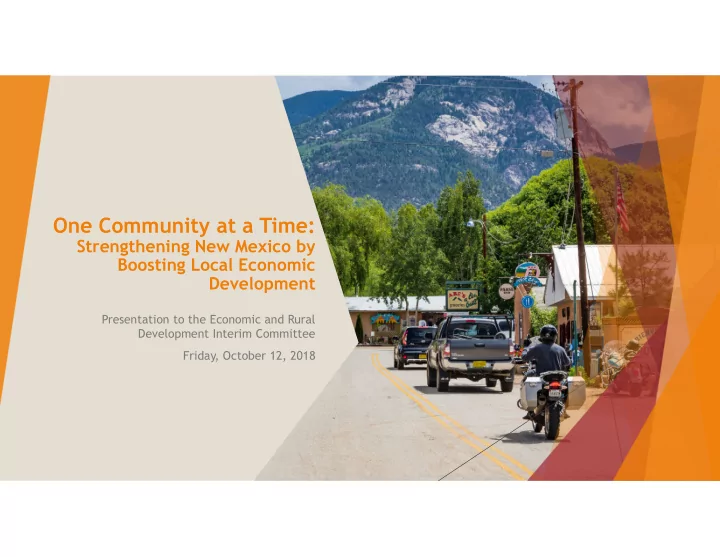

One Community at a Time: Strengthening New Mexico by Boosting Local Economic Development Presentation to the Economic and Rural Development Interim Committee Friday, October 12, 2018
Presenters • Grant Taylor, Economic Policy New Mexico First Director Mesilla Valley • Davin Lopez, President and Economic CEO Development Alliance • Richard Anklam, President New Mexico Tax Research Institute and Executive Director
Today’s Major Points 1) Concern: Economic development starts at home, and yet NM under-invests in local economic development. Especially compared with our neighbor, Texas, which invests at a rate at least four times higher than ours 2) Town Hall Implementation Team Solution : A modest two-step reform to the existing Local Economic Development Act (LEDA) could level the playing field. (Grant Taylor, New Mexico First) 3) Additional reforms ideas exist (not from the town hall): Challenges, other tax considerations (Richard Anklam, NMTRI) Local considerations (Davin Lopez, MVEDA)
What is New Mexico First? Nonpartisan research Civic engagement Advancing change Data Statewide town halls Government policy Policy options Community forums Nonprofit programs Statewide advisors Strategic planning Private sector changes Our greatest legacy: Engaged, informed New Mexicans
RECOMMENDATION: ADVANCE A CULTURE OF ECONOMIC DEVELOPMENT ACTION: Create a culture of economic development with robust local and state funding. STRATEGIES: a) Support economic development organizations locally to increase effectiveness and capacity for growing the economy. b) Promote regionalism in economic development efforts. c) Substantially increase and stabilize funding, specifically for economic Today’s Presentation development to become competitive with other states. d) Substantially increase the state’s annual investment in economic growth and projects, and establish metrics. f) Grow border economies by developing a statewide supply chain.
2019 State Business Tax Climate Index Four Corners-Plus Review Arizona, Colorado and Utah appear to not have municipal- or county-level local-option taxes for economic development projects. Source: Tax Foundation
Enterprising Texas Texas economic development success is clear In 10 years, Texas created 2.18 million jobs – more than New Mexico’s population 300,000 jobs were created in 2017 alone Texas State Incentives ENTERPRISE FUND (CLOSING FUND) $230 MILLION Texas Enterprise Fund Event Trust Funds Financing Grants Tax Incentives Workforce Development Funds Sources: Office of the Governor of Texas; Texas Economic Development Corp.
Texas Tax Structure Supports Municipalities Municipalities are primarily funded with property taxes Texas’ sales and use tax = 6.25% AND municipalities may, with voter approval, add up to 2% for local purposes Prevailing effective TX sales tax rate = 8.25% Local Sales Taxes Economic Development Corporation (EDC) 500 COMMUNITIES Taxes Municipal Development District $738 million* Property Tax Relief Sports and Community Venue Street Maintenance and Repair *Local economic development tax revenue for FY 2015 Source: Texas Comptroller of Public Accounts
Texas Economic Development Taxes 1979 - Texas Legislature enacted Development Corporation Act . Municipalities could form nonprofit economic development corporations (EDCs) to promote industrial development. For each type, up to one-half of one cent of sales may be collected to pay for land, buildings, equipment, facilities expenditures, targeted infrastructure and improvements. Local option (voter approval) Source: Texas Municipal League
NM Local Economic Development Act Municipal GRT- primary funding source for NM municipalities. Often makes up > 70% of general-fund revenues. 1994 – NM voters passed constitutional amendment to “allow public support of economic development.” LEDA Enables municipalities to offer money, land, buildings and infrastructure to qualifying entities for eligible economic-development projects Municipalities may ask voters to approve an eighth-cent tax of the Municipal Infrastructure GRT to “further or implement economic development plans and projects.” The catch – Of that tax, municipalities cannot spend more than $50,000 or 10 percent of the revenue collected on economic development contracts. This means we are not funding our people who do the heavy lifting.
LEDA: Bottom Line While Texas communities are collecting AT LEAST 50 cents per $100 of sales for economic development New Mexico communities that have the eighth- cent GRT are collecting ONLY 12.5 cents per $100 of gross receipts.
Possible solution-Revise LEDA… a little Allow NM communities to raise their eighth-cent LEDA economic development tax to Texas’ half- cent rate If the community wants to. Local vote. Local decision. Lift LEDA’s current restrictions of “the greater of $50,000 or 10 percent” for economic development professional services contracts Allows communities to better invest in their local EDOs.
Disparate Treasure Chests How to measure economic Amarillo EDC MVEDA investment disparity between NM and TX? • Pop: 214,295 Compare Texas EDC’s personnel, • Pop: 190,695 marketing expenditures to total • Personnel • Personnel budget of a New Mexico EDO Expense: Expense: $420,545 $1,023,223 Return? • Budget Reported: • Marketing: Every EDC dollar invested returns $615,000 $17.33 to the local economy $473,504 63 percent of net new jobs • Sales Tax Nearly 55,000 permanent Revenue: Amarillo jobs • $18.5 million $5.5B in gross product is generated each year Sources: U.S. Census Bureau; Guidestar; Albuquerque Business First; Texas Comptroller of Public Accounts; Amarillo EDC
Economic Performance Over Time Amarillo Las Cruces Per Capita GDP $43,664 $32,852 Per Capita Personal Income Source: U.S. Bureau of Economic Analysis
Recap: Close the Gap Possible Reforms Increase the LEDA local option from an eighth of a percent to a half Remove the $50,000/10 percent cap on use of LEDA proceeds for professional services agreements Possible Challenges and Opportunities Elevated effective GRT rate – more than 9 percent in some places
GRT Rate History of Select Cities 8.5% Santa Fe 8.0% Las Cruces Clovis Alamagordo Roswell 7.5% Albuquerque Farmington Rio Rancho Hobbs 7.0% 6.5% 6.0% 5.5% 2002 2003 2004 2005 2006 2007 2008 2009 2010 2011 2012 2013 2014 2015 2016 2017 2018
Other Local Reform Considerations Permanent funding vehicle for economic development Support and align marketing and business retention & expansion (BR&E) efforts Partnership marketing budget increase (endorsed by 2016 NMF town hall) Regional EDO financial support of BR&E (endorsed by 2016 NMF town hall) High Tech Start-up Support- Existing Programs Financing Facility Development- Existing Programs Talent Recruitment Initiatives
Questions?
Thank You! www.nmfirst.org @NewMexicoFirst
Recommend
More recommend